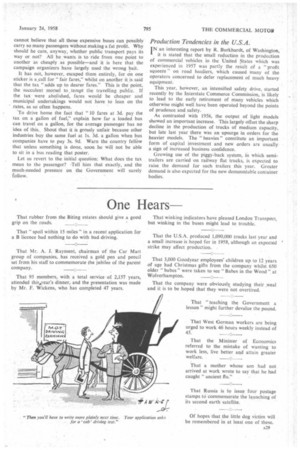Passing Comments
Page 30

Page 31

If you've noticed an error in this article please click here to report it so we can fix it.
Use of Oil-insulated Coils
I GNITION coils of the oil-filled type are becoming increasingly popular with vehicle users. They seem to have an exceptionally long life and breakdowns resulting from any faults in them, are remarkably few, despite the fact that under-bonnet temperatures are often high, One reason for this efficiency is that the oil, which • flows around the windings and against the metal case, can quickly dissipate heat. With normal, solid insulation the heat can remain largely concentrated and there may be a falling off of effective voltage from this cause.
It is as well to remember that any coil is called upon to transform 6 or 12 volts into pulsations in the neighbourhood of 30,000 volts several thousands of times a minute, which is a great deal to expect from such a small component.
Normally, the employment of an oil-coil necessitates little or no alterations to other ignition components or to the carburetter, although, in the case of sparking plugs, where any choice of gap setting is recommended, the wider may be advantageous, unless missing occurs under rapid acceleration in top gear under load.
In some cases, where economy is of great importance, rather wider plug gaps and a weaker mixture may be used. In most instances coils of this type can be mounted in any convenient position and not necessarily quite or almost vertical.
Strengthen That Anti-tax Campaign
"W the
HAT does e 2s. 6d. a gallon tax on bus fuel mean to passengers? During the next few weeks, the four major operators' associations will try to bring home to their customers the impact of this burden by displaying coloured window-bills in their buses and distributing anti-tax pamphlets. This is one of the most intensive and expensive campaigns that they have ever undertaken, but after examining the posters_and pamphlets, one wonders A28 if they are quite on the right track to gain the support they need so badly as a vital aid to bus economics.
Their slogan: "The 2s. 6d. a gallon tax on bus fuel must go" is the theme of five of the stickers. The other asks: "Why should bus fuel carry such a heavy tax?" Passengers are urged to prod their M.P.s and send rockets to Westminster, yet they are not told why with sufficient emphasis and clarity.
In fact, the public could hardly be blamed for wondering why they should help the bus companies and undertakings to swell their profits, for, make no mistake about it, the man in the street is far from convinced that operators are in the plight that they claim.
He is suspicious about the figures put before him, and cannot believe that all those expensive buses can possibly carry so many passengers without making a fat profit. Why should he care, anyway, whether public transport pays its way or not? All he wants is to ride from one point to another as cheaply as possible—and it is here that the campaign organizers have largely used the wrong bait.
It has not, however, escaped them entirely, for on one sticker is a.call for "fair fares," whilst on another it is said that the tax "adds up to dearer fares." This is the point, the succulent morsel to ,tempt the travelling public. If the tax were abolished, fares would be cheaper and municipal undertakings would not have to lean on the rates, as so often happens.
To drive home the fact that "10 fares at 3d. pay the tax on a gallon of fuel," explain how far a loaded bus can travel on a gallon, for the average passenger has no idea of this. Shout that it is grossly unfair because other industries buy the same fuel at Is. 3d. a gallon when bus companies have to pay 3s. 9d. Warn the country fellow that unless something is done, soon he will not be able to sit in a bus reading that poster.
Let us revert to the initial question: What does the tax mean to the passenger? -Tell him that exactly, and the much-needed pressure on the Government will surely follow.
Production Tendencies in the U.S.A.
IN an interesting report by R. Burkhardt, of Washington, I it is stated that the small reduction in the production of commercial vehicles in the United States which was experienced in 1957 was partly the result of a "profit squeeze" on road hauliers, which caused many of the operators concerned to defer replacement of much heavy equipment.
This year, however, an intensified safety drive, started recently by the Interstate Commerce Commission, is likely to lead to the early retirement of many vehicles which otherwise might well have been operated beyond the points of prudence and safety.
As contrasted with 1956, the output of light models showed an important increase. This largely offset the sharp decline in the production of trucks of medium capacity, but late last year there was an upsurge in orders for the heavier models. The " heavies " constitute an important form of capital investment and new orders are usually a sign of increased business confidence.
Growing use of the piggy-back system, in which semitrailers are carried on railway flat trucks, is expected to raise the demand for such trailers this year. Greater demand is also expected for the new demountable container bodies.




































































































